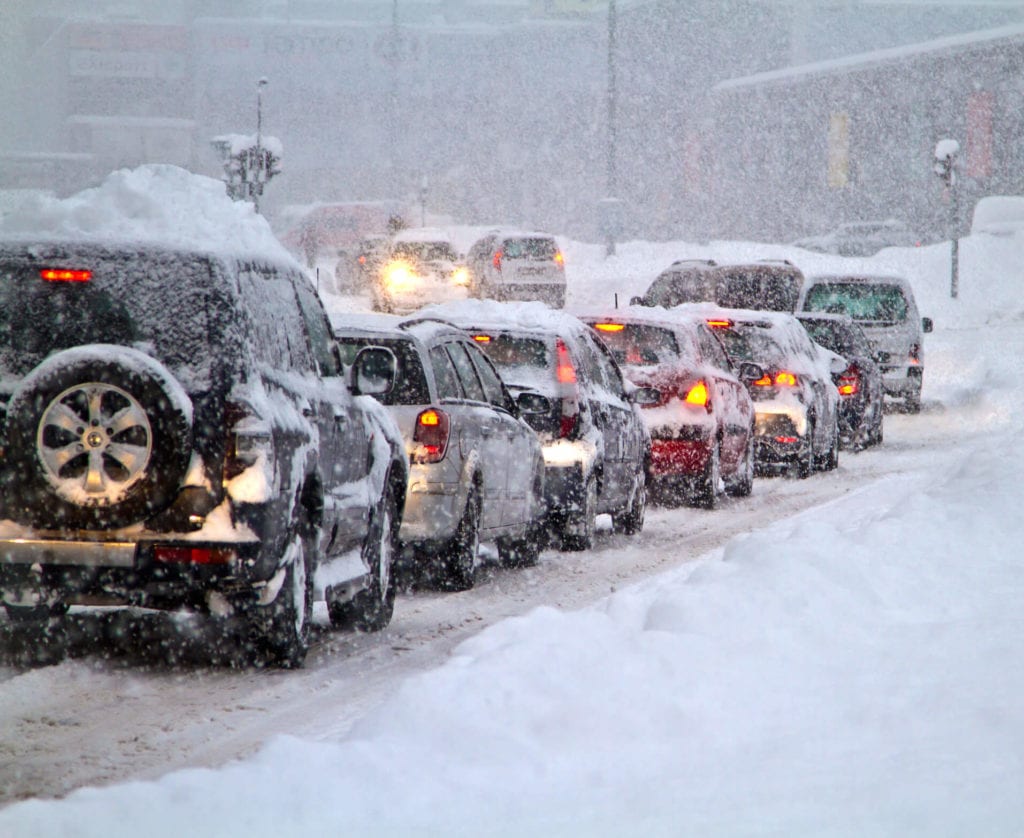
Snow is beautiful, isn’t it? Everything covered in a white blanket seems to make the world around us feel more peaceful—that is until you have to
drive in it. Many people fear driving in snowy and icy conditions, thanks to the media showing images of cars sliding all over and plowing into guard rails and other cars. If you plan to travel into a winter wonderland this season, whether you’ve never driven in wintery conditions or you’re an old pro, prepare yourself for the drive with our winter driving safety tips.
Plan Ahead
Start your journey on the right foot by doing a few things before you leave home. Preparing ahead of time will give you the confidence you need to travel safer and smarter.
- Have your vehicle inspected or serviced. A breakdown at any time of year is no fun, but a breakdown in winter is not only inconvenient, but it could also be very dangerous. Get ahead of the weather by ensuring your vehicle is in prime working condition by visiting your local service center. Have a technician perform routine maintenance and inspection to look for leaks, check the condition of belts and hoses, or other necessary repair services.
- Check for recalls. Recalls happen for vehicles all the time, but not all of them make the evening news. Stay ahead of any safety or maintenance recalls by downloading the myCarfax app to your phone or visit the NHTSA’s website to enter your Vehicle’s Identification Number (VIN). In less than five minutes you’ll be able to determine if your vehicle has a critical safety recall and what steps to take next.
- Check the weather forecast and plan your travel route. Check weather, traffic, and road conditions before you leave home. You may be able to dodge dangerous situations or long periods of sitting in traffic by leaving after bad weather or accidents have cleared. Don’t feel hurried to arrive at your destination, give plenty of extra time to allow for unexpected delays. Familiarize yourself with your travel route prior to your trip, even with the use of a GPS, and share your route with others as well as your expected arrival time.
- Take breaks. On long drives, plan to make stops along your journey to stretch your legs, get a cup of coffee or a bite to eat, and rest if you are drowsy.
- Keep your gas tank full. Even if you drive a hybrid vehicle, try to keep your gas tank as close to full as possible and stopping to refill at least once every couple of hours. If you happen to get stuck in traffic or caught in the snow, you may need the extra fuel to get to your destination or to keep warm.
Driving in Snowy Conditions
The best thing to do whenever any kind of precipitation is coming down is to drive slowly. It’s more difficult for a vehicle to stop or stay in control on snowy or slick roads. Also, increase the amount of space between you and the car in front of you, so that you’ll have plenty of time to stop.
Beware of black ice. Black ice is transparent ice that assumes the color of the road’s surface. As temperatures rise throughout the day, the top layer of ice begins to melt causing a very dangerous and slick area. Tires are unable to provide the traction required to stay in contact with the road, which leads to a loss of control and accidents. Drivers should take extra caution on bridges and overpasses, as these surfaces are more likely to have black ice on them. Cold air is able to access both the top and bottom of these structures, causing the area to freeze much faster than the road or highway. During daylight hours, black ice is fairly easy to identify but is trickier after dark. When you approach black ice, remain calm, avoid hitting the brakes or making sudden movements with the steering wheel, take your foot off the gas pedal and coast through the area. Once the vehicle begins to slow down, your tires will once again be able to grip the road.
Purchase Tire Chains
Laws regarding chains vary state by state. Even if your state does not require them, when you’re traveling somewhere where they are, you’re better off being prepared by having them on hand. In most mountainous areas, tire chains are required on every vehicle for travel, even vehicles that may be equipped with snow or studded tires.
At the very minimum, two sets of chains should be used on your vehicle. Rear-wheel drive vehicles are required to place chains on the rear tires while front-wheel drive vehicles must put snow chains on the front tires. Four wheel drive vehicles may differ, so be sure to consult your owner’s manual. For best results, use chains on all four tires. By using four chains, you are able to obtain better traction and balance.
Prevent and Correct a Slide
Beware of unfavorable weather conditions and slow down to less than 45 MPH in icy and snowy conditions. How to correct a slide:
- Don’t hit the brakes! Braking causes slides and can make things worse.
- Turn into the slide. Turn the steering wheel into the direction of where the back of the vehicle is sliding. If the rear of your vehicle is sliding to the left, turn the wheel to the left. As the car straightens out, straighten the steering wheel, slowly and carefully.
- Don’t panic or overcorrect. Oversteering can make this already precarious situation worse and into an irreparable spin. An oversteering skid gives the car angular momentum, forcing the car to rotate faster than steering can respond, sending the car into a full spin.
